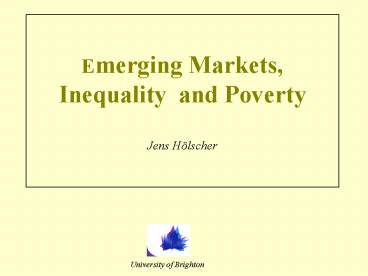Emerging Markets, Inequality and Poverty Jens H - PowerPoint PPT Presentation
Title:
Emerging Markets, Inequality and Poverty Jens H
Description:
Title: Money and Credit Market Integration in the Run Up of EU Eastern Enlargement Jens H lscher University of Brighton Author: jh320 Last modified by – PowerPoint PPT presentation
Number of Views:84
Avg rating:3.0/5.0
Title: Emerging Markets, Inequality and Poverty Jens H
1
Emerging Markets, Inequality and Poverty Jens
Hölscher
University of Brighton
2
Key questions
- What is the relationship between poverty and
inequality? - Have poverty and inequality increased in the last
decades? - What determines inequality and poverty?
- Is globalisation and growth good for the poor?
- Is there a relationship between inequality and
growth?
3
Structure
- Definitions and measurement
- Empirical evidence
- Inequality and poverty determinants
- Inequality / growth relationship
- Conclusions
4
Definitions I (inequality)
- Between countries (regions) GDP (GNP) per
capita, - of developed countries GNP per capita
- Convergence / Divergence theories
- 2. Within Countries (regions), between social
classes - Theories of functional income distribution
(rentiers, capitalists, workers) Ricardo, Marx,
Neoclassical theory - 3. Within Countries (regions), between
individuals/households - Gini coefficient The Gini coefficient is a
number between 0 and 100, where 0 means perfect
equality (everyone has the same income) and 100
means perfect inequality (one person has all the
income, everyone else earns nothing). - Inequality in income or/and in something else?
- Income (PPP), wealth, consumption, health,
education, etc. - The multidimensional approach (e.g., HDI,
income, life expectancy and educational
achievements)
5
Definitions II (poverty)
- Setting of a poverty line / threshold
- Headcount (Absolute measure)
- n. of people with income below the poverty line
- Poverty rate ( measure)
- of population with income below poverty line
- Poverty deficit
- Sum of all income shortfalls (difference between
the threshold and one's income). Total amount of
money needed to bring all those who are poor up
to the poverty line - Poverty
- - regional, rural, urban, social groups
6
Empirical Evidence
- Geography of
- Between country inequality (GDP per capita)
- Within country inequality (Gini coefficient)
- Poverty (poverty rate)
7
(a) Inequality between countries (i)
Per capita GDP (PPP), 2007-2008
8
(a) Inequality between countries (ii)
GDP real growth rate 2007
9
(a) Inequality between countries (iii)
Convergence / Divergence
10
(b) Inequality within countries
Gini Coefficient 2007-2008 UN Human development
report
11
(c) Poverty
of population living with less than 1.25 PPP
per day (2009)
12
Determinants of inequality and poverty
- Economic and structural factors
- Stage of development (Kuznets hypothesis)
- Growth (pro-poor / pro-rich growth)
- Industry structure of the economic system and
technical change - Credit constraints and development of financial
markets - Openness of the economic system
(globalisation/growth)
- Social and demographic factors
- Human capital endowment and its distribution
- Age structure of the population
- Population heterogeneity
- Participation to labour market (especially
female)
- Institutional factors
- Labour market institutions
- - Social security systems
Empirical evidence inconclusive (both and
effects reported) Problems of reverse causality
13
Effects of inequality on growth possible
trasmission mechanisms
INEQUALITY IS HARMFUL FOR GROWTH
INEQUALITY IS HELPFUL FOR GROWTH
Inequality provides incentives to work harder and
to undertake risks / investments
political economy channel (PTs two stage model)
social dissatisfaction and conflicts
saving / consumption behaviours (rich save more
S I)
Poor do not have access to education, no access
to human capital, weak growth (importance of
financial/credit markets)
If very high levels of HC favour growth, an
unequal society can allow a few (very rich)
people to reach those levels
Empirics contrasting. After dominance of the
harmful view (90), recent evidence supports
the helpful view
14
Conclusions
- Renewed interest of the scientific community and
policy makers on inequality and poverty - Determinants of inequality and poverty are many
and interrelated measurement problems do not
help disentangling the complexity - Relationship between globalisation and
poverty/inequality is ambiguous - Similarly, the growth/inequality and the growth /
poverty relationship is uncertain - What is certain is instead that poverty needs a
global response, but supranational institutions
aimed at fighting poverty are still lacking
15
Reading
- World Development Report
- Wade, R. H. (2003) Globalisation, Poverty and
Income Distribution Does the Liberal Argument
Hold? - Hölscher, J. (2006) Income Distribution and
Convergence in the Transition Process - A Cross
Country Comparison, in Comparative Economic
Studies, Vol. 48, No. 2 (June 2006) - Mitra, Pradeep and Ruslan Yemtsov (2006),
Increasing Inequality in Transition Economies
Is There More to Come? World Bank Policy
Research Working paper, No. 4007. - Milanovic, B. (2008), Reform and Inequality
during the Transition. An Analysis Using Panel
Household Survey Data, 19902005, World Bank
Policy Research Working paper, No. 4780 - Chaudhuri, S. and Ravallion, M. (2007),
Partially awakened giants uneven growth in
China and India, World Bank Policy Research
Working paper, No. 4069 - Perugini, C. and Bracalente, B (forthcoming),
The Components of regional disparities in
Europe, Tha Annals of regional Science,
forthcoming - Cline, W. (2002), Financial Crises and Poverty
in Emerging Market Economies, Center for global
development working paper, n. 8.































